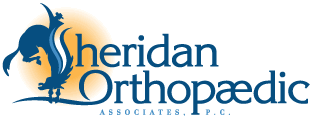Learn About Our Shoulder Procedures
Select a procedures to expand details:
Total Shoulder Replacement
Total Shoulder Replacement and Reverse Total Shoulder Replacement are highly effective surgical treatments for those experiencing shoulder pain as a result of arthritic conditions, chronic rotator cuff tears, or other joint dysfunction. The choice of technique and implant design depends on the specific condition, and the options may be discussed with your surgeon.
To begin the procedure, the surgeon will make an incision on the front of the shoulder and carefully protect the surrounding muscles and nerves while exposing the shoulder joint.
Next, the damaged cartilage on the end of the humerus (ball) and scapula (socket) is completely removed, along with a small amount of the underlying bone. The space created by the removal of cartilage and bone is then replaced by metal and plastic implants positioned and sized to fit your specific anatomy.
These new components create a smooth surface for the shoulder joints to glide on and resembles the natural anatomical movement of the shoulder. The joint is then closed over the implants and the incision is closed in layers with sutures. Staples or stitches may be used to close the skin.
Arthroscopic Rotator Cuff Repair
Rotator Cuff Repair is surgical procedure used to alleviate pain caused by a torn rotator cuff in the shoulder. This procedure uses one or more small incisions and small endoscopic cameras to allow surgeons to view damage to the area around the shoulder in high definition.
To begin this procedure, the surgeon will make one or more small incisions around the shoulder area where the pencil sized cameras and surgical instruments will be inserted. Next, a clear sterile fluid is injected that allows the surgeon to visualize the shoulder in greater detail.
Once the shoulder has been examined, the surgeon may use bone anchors or semi-permanent stitches to repair the damaged cartilage, joint capsule or ligaments back down to the socket of the shoulder. Once these portions have been securely reconnected the incisions are closed with small stitch or sterile strips.
Shoulder Debridement
Shoulder Arthroscopy is one of the more common procedures for shoulder conditions. This procedure uses one or more small incisions and small endoscopic cameras to allow surgeons to view damage to the shoulder joints, bones or cartilage in high definition. Once the camera has been inserted, the surgeon uses microsurgical tools to remove damaged tissue or debris that is causing shoulder pain.
To begin this procedure, the surgeon will make one or more small incision around the damaged area where the pencil sized cameras and surgical instruments will be inserted. Next, a clear sterile fluid is injected that allows the surgeon to visualize the area in greater detail.
Once the surgeon has visualized and evaluated the area, the surgeon may decide tissue or ligaments need to be trimmed or partially removed. Small surgical instruments are inserted to remove the painful tissue or ligaments. The incisions are closed with small stitch or sterile strips.
Labral Repair
Labral Repair of the Shoulder is an effective surgical procedure used to treat shoulder pain associated with a torn labrum. The goal of this procedure is to repair the tendon that has become damaged or torn and is causing symptoms.
To begin this procedure, the surgeon will make one or more small incisions on the shoulder where the pencil sized cameras and surgical instruments will be inserted. Next, a clear sterile fluid is injected that allows the surgeon to visualize the area in greater detail.
Depending on the type and extent of damage, the surgeon my either remove the torn areas and debris or repair the torn tissues. For this repair, small instruments are used to pass sutures around the torn tissue and it is reattached to the bone using specialized “anchors”. The incisions are then closed with a few small stitches.
Bankart Repair
Bankart Repair is an arthroscopic procedure used to treat shoulder instability or prevent recurrent dislocation by repairing the cartilage around the glenoid (shoulder socket).
To begin this procedure, the surgeon will make two or more small incisions around the shoulder area where a pencil-sized camera and surgical instruments will be inserted. Next, a clear sterile fluid is injected that allows the surgeon to visualize the shoulder in greater detail.
Using the specialized instruments, the cartilage labrum around the glenoid is repaired using small sutures and/or anchors placed in the bone. The repair of this cartilage allows the humerus to stay centered inside the socket. The incisions are closed with a few small stitches.
AC Joint Repair
The Acromioclavicular Joint (AC Joint) is the joint that connects the collarbone (clavicle) to the shoulder blade (scapula) at the top of the shoulder. If this joint is injured (or “separated”), the result can be pain, weakness, or abnormal motion at the AC joint. There are several techniques that might be used to repair or reconstruct the injured ligaments. The various techniques use combinations of strong, synthetic cord and/or a cadaver tendon to reconnect the clavicle to its attachments on the scapula.
To begin this procedure, the surgeon may perform arthroscopy first. This involves making one or more small incisions around the shoulder area where a pencil-sized camera and surgical instruments can be inserted in to the shoulder joint. Next, a clear sterile fluid is injected that allows the surgeon to visualize the shoulder. Other problems within the shoulder can be addressed at this time and/or the arthroscopic camera may be used to assist with the repair.
If the reconstruction is done using an open technique, the surgeon may proceed without arthroscopy by making an incision on the front of the shoulder. The ligaments are then reconstructed between the two bones under direct vision. The tissues are then closed in layers using sutures and the skin is closed with either stitches or staples.
